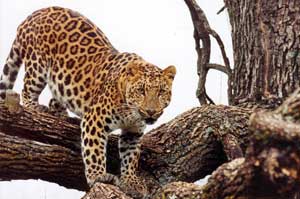Amur Leopard (Panthera pardus orientalis)

The amur leopard is classified as a member of the order Carnivora (Carnivores) and is a member of the family Felidae. It is classified as a critically endangered species due to a reduction of at least 80% of its population over the past three generations because of a decline in area of occupancy, extent of occurance, or quality of habitat. The amur leopard population is also estimated to be less than 50 mature individuals. Amur leopards can be found in eastern Asia.
Status in the Wild: Endangered species
Range: Amur River valley of Siberia and Manchuria, Korea
Habitat: Temperate forests
Description: The Amur leopard is adapted to living in cold, snowy climates with their long legs and hair as well as living in regions with summer temperatures from 77 to 95 degrees. The hair is a light hue in winter and a reddish-yellow hue in the summer. The rosette spot patterns are widely spaced and are large with thick borders, usually having no spaces between the spots. This cat can run at speeds of 37 miles per hour for short periods of time.
Conservation Status: The Amur leopard is listed as an endangered species by the United States Fish and Wildlife Service and as an Appendix I species under the Convention on International Trade in Endangered Species of Wild Fauna and Flora (CITIES).
The leopard Panthera pardus, has one of the widest distributions in the cat family. Many sub-species occur throughout their range in Africa and Asia. The Amur leopard is the most northern race with a wild population of 55 individuals. The American Zoo and Aquarium Association manages a captive population through the International Leopard Studbook which registers over 200 captive Amur leopards worldwide. This population may be the only hedge against extinction as the wild population continues to decline.
Threats to Species: Habitat destruction, loss of prey species, poaching for the fur trade, and trophy hunting have all contributed to the decline of the Amur leopard.
Lifespan: The approximate life span is 17 years in captivity. The male leopard at the Central Florida Zoo was born in 1996 at the Sedgwick County Zoo in Kansas.
Weight: Average adult weight for a male is 70 to 130 pounds and the average weight for a female is 55 to 95 pounds.
Diet: At the Zoo, leopards are provided with a commercially prepared meat diet containing vitamin and mineral supplements. In the wild, these cats prey on deer, wild boar, and small mammals.
Social Organization: The Amur leopard is a solitary animal. They stalk their prey and eat alone, sometimes leaving leftovers in the trees for a later time. They are good climbers and nocturnal animals.

